![]()
![]()
![]()
Use LEFT and RIGHT arrow keys to navigate between flashcards;
Use UP and DOWN arrow keys to flip the card;
H to show hint;
A reads text to speech;
86 Cards in this Set
- Front
- Back
|
In how many parts thorax is divide? |
Two a) thorax inlet b) thorax outlet |
|
|
Anteriorly thorax inlet bound with ? |
Suprasternal notch |
|
|
Posteriorly thorax inlet bound with? |
T1 vertebra |
|
|
Thorax inlet is covered by a membrane called? |
Suprapleural membrane or diaphragm of thorax inlet. |
|
|
Anteriorly thorax outlet is bound with? |
Xiphoid process. |
|
|
Posteriorly thorax outlet is Bound with ? |
T12 vertebra |
|
|
On each side of thorax outlet how many costal cartilage and ribs are present? |
6 costal cartilage and one rib |
|
|
Thorax outlet is closed by? |
Abdominal diaphragm or diaphragm of thorax outlet. |
|
|
On each side upper border of manubrium has? |
Clavicular notch |
|
|
Ist costal cartilage articulates with manubrium by? |
Primary cartilaginous joint |
|
|
Sides of Lower part of manubrium articulates with? |
2nd rib |
|
|
Rib attaches with body as well as manubrium is? |
2nd rib |
|
|
Xephoid process and body articulates with each other by a joint called? |
Xephisternal joint. |
|
|
Each Side of upper part of body articulates with? |
2nd rib |
|
|
Each side of lower part of body articulates with? |
7th rib |
|
|
Rib attaches with xephoid process as well as body is? |
7th rib |
|
|
From 1_7 costal ribs articulates with Sternum by a joint called ? |
Synovial joint. |
|
|
Ist costal rib attaches with sternum through? |
Primary cartilaginous joint. |
|
|
Suprasternal notch or jungular junction is opposite to what vertebra? |
Lower border of T2. |
|
|
Sternal angle or angle of Louis opposite to what vertebra? |
Lower border of T4. |
|
|
Xiphi sternal junction is opposite to what vertebra? |
T9 |
|
|
Manubrium is opposite to what vertebra? |
From 3rd vertebra to 4th |
|
|
Body is opposite to what vertebra? |
From 5th vertebra to 8th |
|
|
Xephoid process is opposite to what vertebra? |
T9. |
|
|
No cartilage and rib attach to which part of the sternum? |
Xephoid process. |
|
|
Ribs number? |
24 ribs and 12 pairs |
|
|
Types of ribs on the basis of features? |
A) Typical ribs B) A typical ribs |
|
|
Typical ribs are from? |
3 to 9 rib |
|
|
A typical ribs are? |
First two and last three (1, 2,10,11,12) |
|
|
Ribs on the basis of articulation? |
1.True ribs 2.False ribs |
|
|
True ribs are from? |
From 1 to 7 ribs |
|
|
True ribs is called? |
Vertebrosternal ribs Reason:directly join to the sternum. |
|
|
False ribs are from? |
From 8 to 12 ribs |
|
|
8 9 10 ribs are? |
Vertebrochondral ribs Reason:it attaches to the sternum through costal cartilage. |
|
|
11 and 12 ribs are? |
Floating ribs |
|
|
Posterior end of typical ribs consist of how many parts? |

1) Head 2) Neck 3) Tubercle |
|
|
Head consists of how many parts? |
Three 1) superior facet 2) Ridge 3) inferior facet |
|
|
Superior facet articulates with? |
Previous vertebra |
|
|
Ridge articulates with? |
Intervetebral disk |
|
|
Inferior facet articulates with? |
Corresponding vertebra |
|
|
Tubercle consists of how many parts? |
Two 1) articular part 2) non articular part |
|
|
Articular part of tubercle articulates with? |
Transverse process |
|
|
Non articular part of tubercle articulates with ? |
Ligament |
|
|
Anterior end of typical ribs articulates with costal cartilage by a joint called? |
Costo condrial joint |
|
|
First rib is the? |
Shortest and broadest. |
|
|
On inner border of the first rib a tubercle is present called? |

Scalene tubercle. |
|
|
A muscle attaches to the scalene tubercle called? |
Scalenus anterior muscle. |
|
|
On upper side of first rib a muscle is present called? |
Scalenus medius |
|
|
Scalene tubercle is related to how many grooves? |
Two A) front groove B) behind groove |
|
|
Front groove is related to? |
Subclavian vein |
|
|
Behind groove is related to? |
Subclavian artry |
|
|
Neck of first rib is related to how many structures? |
4 Two vessels Two nerves. |
|
|
From medial to latereal structure of the neck are? |
1) sympathetic chain 2) superior intercostal artry 3) ist posterior intercostal vein 4) ist thorasic nerve T1. |
|
|
We count number of ribs and intercostal space from? |
Sternal angle |
|
|
Number of vertebrae in our body? |
33 A) 7 cervical B) 12 thorasic C) 5 Lumber D) 5 Sacral E) 4 cocyx |
|
|
Typical vertebra consists of how many parts? |
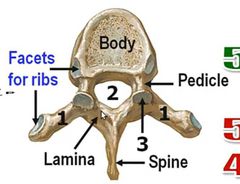
A) Body B) Vertebral arch or neural arch |
|
|
Vertebral arch or neural arch consists of how many Pedicles and lamina? |
Two |
|
|
Lamina of the vertebral arch or neural arch are fuse to form a? |
Spine. |
|
|
Body of the vertebrae and neural arch or vertebral arch are seperated by? |

Vertebral canal |
|
|
At the junction of Pedicles and lamina how many processes are present? |
Six |
|
|
Processes present at the junction of lamina and Pedicles are? |
2 transverse processes 2 superior articular processes 2 inferior articular processes |
|
|
How we can identify a cervical vertebrae? |
It has foramen in transverse process . |
|
|
Foramen is present in all? |
Cervical vertebrae |
|
|
How we can identify thorasic vertebrae? |
It's consists of costal facets which articulates with the ribs. |
|
|
How we can identify lumber vertebrae? |
It has no foramen and no costal facets. |
|
|
Gross features of the lung are? |

1) Apix 2) Base 3) 2 surfaces (medial and costal surface) 4) 3 Borders (Anterior(sharp) ,posterior(rounded)and inferior(which seperate base from other surfaces) |
|
|
Gross features of the lung are? |
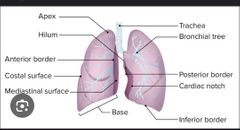
1) Apix 2) Base 3) 2 surfaces (medial and costal surface) 4) 3 Borders (Anterior(sharp) ,posterior(rounded)and inferior(which seperate base from other surfaces) |
|
|
Fissure which is present in the two lungs is called? |
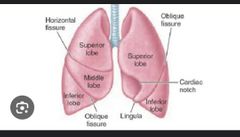
Oblique fissure |
|
|
Fissures present in the right lung is called? |

Oblique and horizental fissure |
|
|
Right lung is divided into how many lobes? |
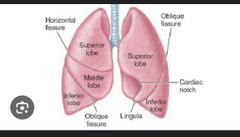
3 lobes upper middle and lower |
|
|
Left lung is divided into how many lobes? |

2 upper and lower |
|
|
Apex of the lungs extend to? |
Root of the neck |
|
|
Apex of lungs is covered by a memebrane called? |
Suprapleural memebrane. |
|
|
Base of the lungs lies on the? |
Upper surface of Diaphragm |
|
|
Anterior border of Right lung is? |
Straight |
|
|
Anterior border of left lung has? |
Cardiac notch and lingula |
|
|
Cardiac notch of left lung is opposite to which intercostal spaces? |
4th and 5th intercostal spaces |
|
|
Inferior border separate base from? |
Other surfaces. |
|
|
Typical thorasic vertebrae are from? |
2 to 8 |
|
|
Sternum is divide into ? |

A) Manubrium B) Body C) Xephoid process |
|
|
Manubrium upper border has a junction called? |

Jungular notch or suprasternal notch. |
|
|
The articulation of manubrium with the body forms an angle called? |
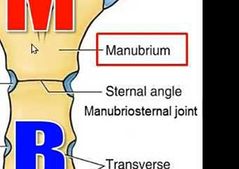
Sternal angle or angle of louis. |
|
|
On each side the upper part of manubrium articulates with? |
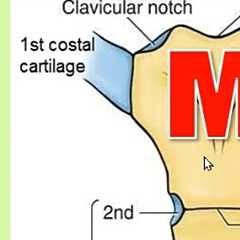
Ist costal cartilage. |
|
|
Upper part of body articulates with? |
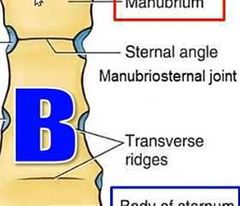
Manubrium by sternal angle |
|
|
Lower part of body articulates with? |

Xephoid process . |
|
|
Costal groove contains? |
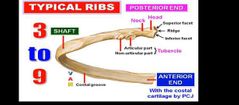
Intercostal veins Intercostal arteries Intercostal nerves. |

